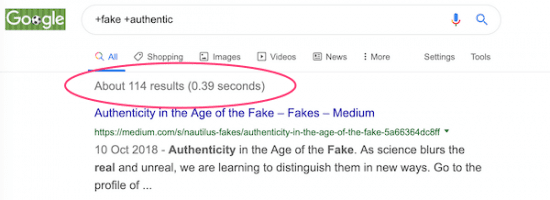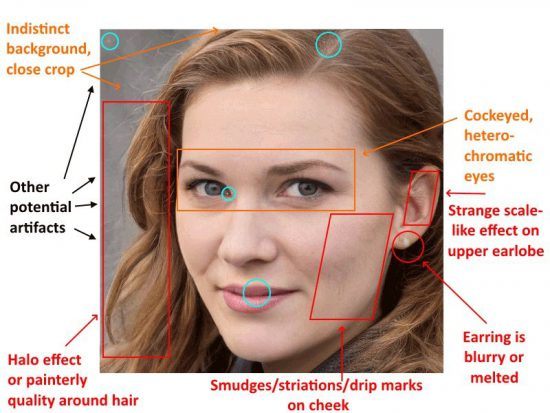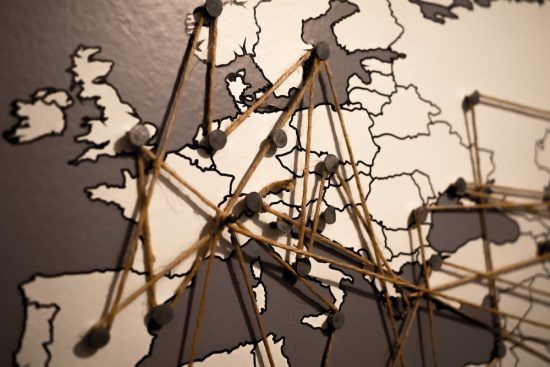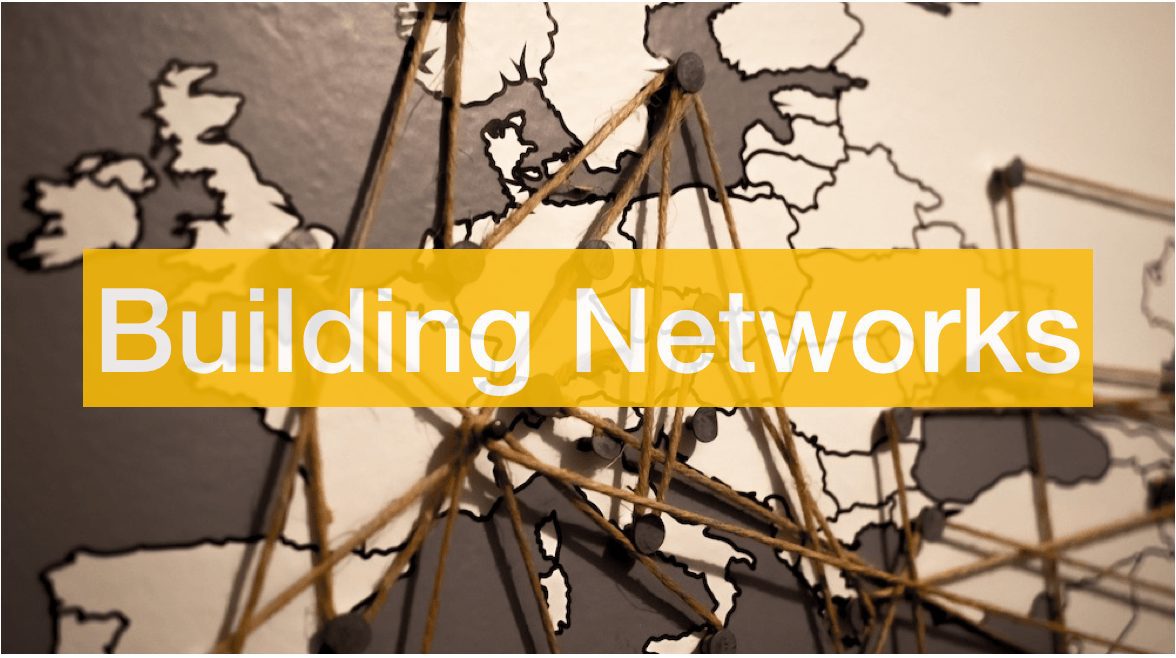It’s rather amazing how frequently the words “fake” and “authentic” appear in published articles or are mentioned in talks about our digitally infused world. Ironically, though, these two words seem rarely to be mentioned in the same article. To validate this thought, I did a Google search. It showed today that there are about 1.2 million results for “authentic” and 1.1 million results for “fake.” Yet, when I search for the term “+fake +authentic” (i.e. both words must appear in the same page), there are only 114 results!

Is it possible the quest for authenticity and the surge in (deep) fake news have a relationship? I now have new evidence to support the fact that they are entirely linked and we should be even more aware of this duo of words as we look to build our network and reputation. And, it should definitely be enough to change the way you approach your Linkedin network building.
Relationship building
It has long been a facet of our human existence — in work and in our personal lives — the importance of developing strong and reliable relationships and building out our network. I like to say that “I am my network.” For sure, we are as strong as our network. These relationships are now playing out in digital ways, with various new twists and challenges, but also with great advantages compared to the old analogue days. The way and the reason you would connect with someone on Facebook is different from the one on Twitter, Instagram, WeChat and Linkedin, etc. And the differences will vary across generations and cultures.
Creating a network on social media

For Facebook and LinkedIn, where the relationship is designed to be mutual (whether friend or connection), both sides of the equation must find a common reason for connecting; and both must accept the other (notwithstanding the fact that one initiates the request). In the case of Facebook, as we know, it’s broadly about being “friends.” On LinkedIn, meanwhile, it’s much more about business, our professional connections. Here’s a good gauge of how different each network is: on Facebook I want people to whom I will be happy to send happy birthday greetings and to see photos that are of more intimate nature. On LinkedIn, I rarely say Happy Birthday to someone in my network (unless perhaps it’s a good friend and I’m too lazy to change over). I save my personal well wishes for Facebook.
Trust is the core to a strong network
But, in both cases, there is an implicit level of trust that brokers, if not forms, the connection. I try to apply the same approach online as I would offline in terms of establishing a trusted network. For the longest time, I have been explaining my philosophy about the types of connections I pursue on Linkedin:
On Linkedin, it’s about having people I know and trust; and whom I’d recommend or feel at ease to reach out to.
In my monthly purge of the hundreds requests I receive from people I don’t know, I make the effort to respond to all the strangers and to explain my philosophy. For about half, I get no answer at all, which patently demonstrates the shallowness of their request (and, as far as I’m concerned, the unreliability of the connection). For some, they kindly reply and admit that they have the same policy (which always brings out a smile). In some of the responses, I inevitably get a few rather peeved or defensive messages. I have laid out my precise approach in various blog posts in the past:
- “How Best To Handle Those Linkedin Connection Requests?”
- “5 Ways to Get a Strong Network on Linkedin”
- “How To Build A Great LinkedIn Network And Why Reducing Your LinkedIn Network May Be Key“
If nothing else, the process of replying to each connection request provides a view into humanity. It also tries to offset my poor memory in case the connection request is legitimate. I don’t deny that my message may not be perfectly worded for each person, but heck, it’s they who asked to be part of my network. For one person recently, he told me that Linkedin is the way that he meets people. Call me old fashioned, personally, I’d rather meet someone IRL and then connect online. If we ‘exchange’ online, I still prefer to meet in person (NB it can be a Skype video) before accepting a LinkedIn connection. I have no problem with following new people (e.g. on Twitter or Instagram). But, it seems that connections on Linkedin should have a somewhat more symmetrical relationship where the link is built on trust.
Accepting strangers and fake accounts?
For those of you who continue to blithely click ACCEPT to requests from people you don’t know (and trust) on LinkedIn, there are two important reasons why you ought to stop doing so.
The lure of a connection of a connection
1/ Let’s imagine you (the reader) and I are connected on Linkedin. If I accept a request from a stranger, that same person will show up as a connection with me when they try to connect with you. You would be lured into accepting based on the assumption that the stranger and I are legitimately connected. If a friend of a friend may be enough for some to connect on Facebook, a connection of a connection in business has other repercussions, including access to important people. I have several people in my network whom I adore and trust, but they have obviously not been selective with their network. If that stranger were to ask my friend to be introduced to me, I dare say that my friend would be hard-pressed to pass along the request with integrity. Otherwise, he would be spoiling my trust in him.
The trickery is going to get worse
But, the new news is what should stop you dead in your tracks. If you’re like me, you will make sure that the person you’re accepting as a connection is bona fide. That usually means verifying the Stan Smith is the Stan you know. You can at the same time check out the bio and see that the profile is up-to-date and active (as opposed to a placeholder or with the equivalent of an egghead). But, our ability to verify errant profiles will is about to be put to the test…

2/ According to this recent AP article, “Experts: Spy used AI-generated face to connect with targets,” there are now scores of fake profiles bouncing around Linkedin. The article explains that “the persona [Katie Jones] was part of a vast army of phantom profiles lurking on the professional networking site LinkedIn. And several experts contacted by the AP said Jones’ profile picture appeared to have been created by a computer program.” That profile disappeared from circulation, but surely many more will be following in its stead. The point is that the profile isn’t only a stranger to you. It’s fake and toxic. If ever there was a time to say, I need to reiterate my rant:
Stop accepting connection requests on LinkedIn from people you don’t know and trust! [And don’t ever connect with a stranger without a legitimate reason and a covering note that explains why the other person ought to wish to connect to you].
Build a strong — not fake — LinkedIn network

As the world of deep fake news continues to develop and get more sophisticated, we would all do well to up our game and be wary of indulging strangers because it’s about being nice, convenient or potential business. Just because it’s free, doesn’t mean you don’t pay. And just because you can [connect with strangers], doesn’t mean you ought to. Because the Linkedin algorithm gives privilege to 2nd degree connections, I affirm that we ought to be far more vigilant about the way we all connect on Linkedin. The integrity of the entire ‘social’ network depends on that integrity. With so much fake ‘stuff’ about, we need to pay particular attention to the authenticity of our relationships in order to build up a strong and effective network, especially on LinkedIn (or other professional networks). Imagine a future where we could use a technology like Blockchain to help us confirm the genuineness of each of our relationships? The chain of links would be verified and trustworthy! Scary or wonderful?
Your thoughts?












Great post Minter.
For me Linkedin connections are definitely in the ‘depends’ bucket and more importantly what are you using Linkedin for?
I’ll connect with people I find interesting e.g. who have written something interesting with a point of view OR those who I think might be useful to me or some of my network…and I have my own checks before connecting (though that only changed in the last year or so). When you’ve travelled as much as we have and genuinely met a lot of people you tend to have a lot of connections and to an outsider it can look like you connect with anyone which in itself breads a lot more requests to connect (and that has got worse with companies now asking you to connect and follow).
I don’t want to ‘not connect’ with someone I may not know for the above reasons.
Fake profiles aren’t good for sure and I know they exist.
I recently reduced my ‘following’ https://www.linkedin.com/feed/following/ down purely to contain the posts I see from people whose posts I really like to read. Linkedin automagically throws you the feeds of people you connect with. it took me a few days as Linkedin don’t like you culling what you read it appears,but now I have a feed that’s useful to me.
Until blockchain we do need to be more diligent and *not* accept every invitation. Realistically if you’re just building the number of connections you have you’re missing the point (I don’t mean you personally) it’s meaningless, you’re not even gaming the system if that’s what you’re trying to do (and that’s nuts anyway) since Linkedin’s algorithm is moving more to be like Google’s for natural search.
I concur with your point “Just because it’s free, doesn’t mean you don’t pay. And just because you can [connect with strangers], doesn’t mean you ought to.”
Peter
Many thanks Peter for your comment. I’m trying to build up an understanding of how people are using Linkedin… In my exchanges with people who are asking to connect, I am starting to get interesting insights into why they send the request (like the fact that you have a large network or know interesting people). When they write that they find me (and the content I post) interesting, I wish the default would be just to follow me, rather than ask to connect.